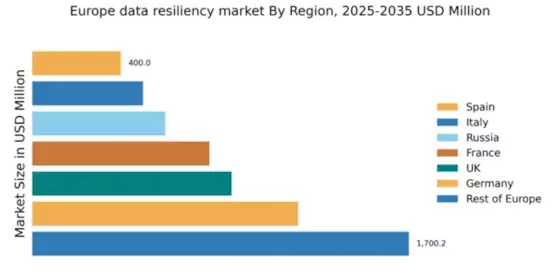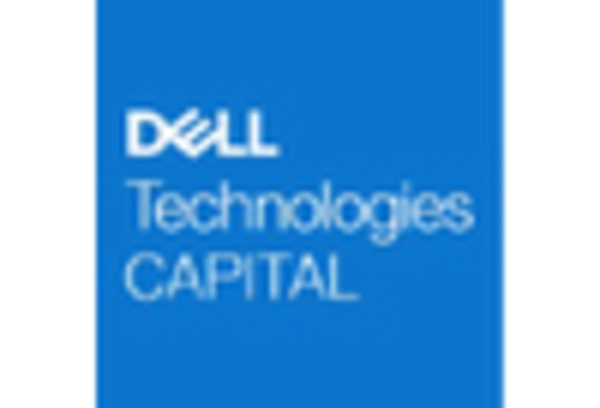Rising Cybersecurity Threats
The escalating frequency and sophistication of cyberattacks in Europe significantly influence the data resiliency market. Organizations face an array of threats, including ransomware and data breaches, which can lead to substantial financial losses and reputational damage. According to recent estimates, the cost of cybercrime in Europe is projected to exceed €1 trillion annually by 2025. Consequently, businesses are increasingly investing in data resiliency solutions to protect their critical assets and ensure business continuity. This heightened focus on cybersecurity is expected to drive market growth, as companies seek to implement comprehensive strategies that encompass data backup, recovery, and protection against evolving threats.
Digital Transformation Initiatives
The ongoing digital transformation across various sectors in Europe serves as a significant catalyst for the data resiliency market. As organizations adopt advanced technologies such as cloud computing, IoT, and big data analytics, the volume of data generated and processed continues to expand exponentially. This surge necessitates robust data resiliency measures to ensure that critical information remains accessible and secure. Market analysts suggest that the digital transformation spending in Europe could reach €500 billion by 2025, with a substantial portion allocated to data management and resiliency solutions. This trend indicates a growing recognition of the importance of data resiliency in supporting innovative business models and enhancing operational efficiency.
Growing Data Protection Regulations
The increasing emphasis on data protection regulations in Europe is a pivotal driver for the data resiliency market. With the General Data Protection Regulation (GDPR) and other national laws, organizations are compelled to implement robust data management strategies. Compliance with these regulations not only mitigates the risk of hefty fines, which can reach up to €20 million or 4% of annual global turnover, but also enhances customer trust. As businesses strive to align with these legal frameworks, investments in data resiliency solutions are likely to surge, reflecting a projected growth rate of approximately 15% annually in the sector. This trend underscores the necessity for organizations to prioritize data resiliency to safeguard sensitive information and maintain compliance.
Shift Towards Hybrid IT Environments
The transition towards hybrid IT environments in Europe is reshaping the data resiliency market. Organizations are increasingly adopting a combination of on-premises and cloud-based solutions to optimize their IT infrastructure. This hybrid approach offers flexibility and scalability, but it also introduces complexities in data management and protection. As businesses navigate these challenges, the demand for data resiliency solutions that can seamlessly integrate across diverse environments is likely to rise. Analysts project that the hybrid cloud market in Europe will grow at a CAGR of 20% over the next five years, driving investments in data resiliency technologies that ensure data integrity and availability across multiple platforms.
Increased Demand for Business Continuity Solutions
The heightened awareness of the need for business continuity in Europe is a crucial driver for the data resiliency market. Organizations are increasingly recognizing that disruptions, whether due to natural disasters, cyber incidents, or operational failures, can have devastating effects on their operations. As a result, there is a growing demand for comprehensive business continuity solutions that encompass data resiliency strategies. Research indicates that companies investing in business continuity planning can reduce potential losses by up to 50%. This realization is prompting organizations to allocate more resources towards data resiliency initiatives, thereby fostering market growth and innovation in this sector.


















Leave a Comment